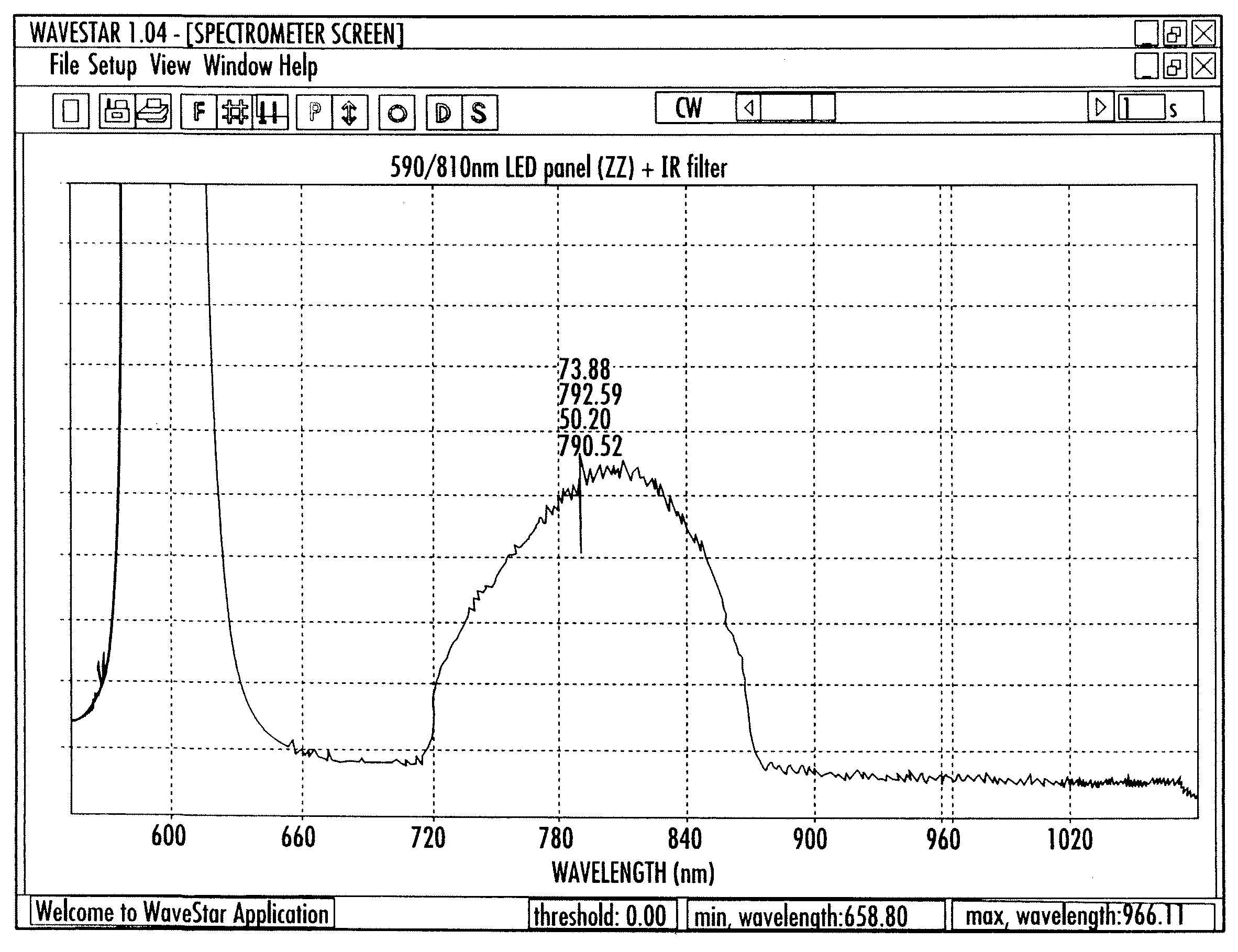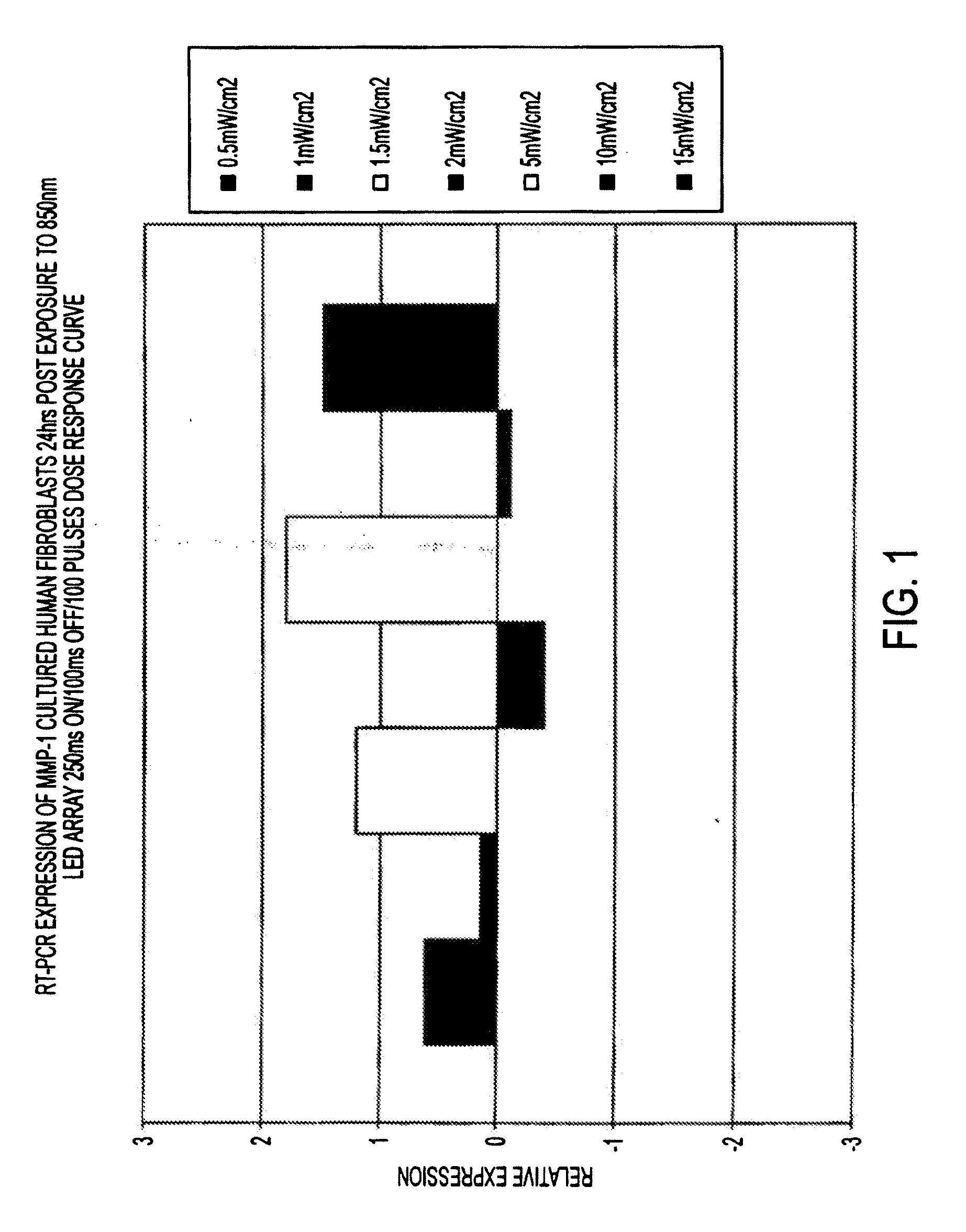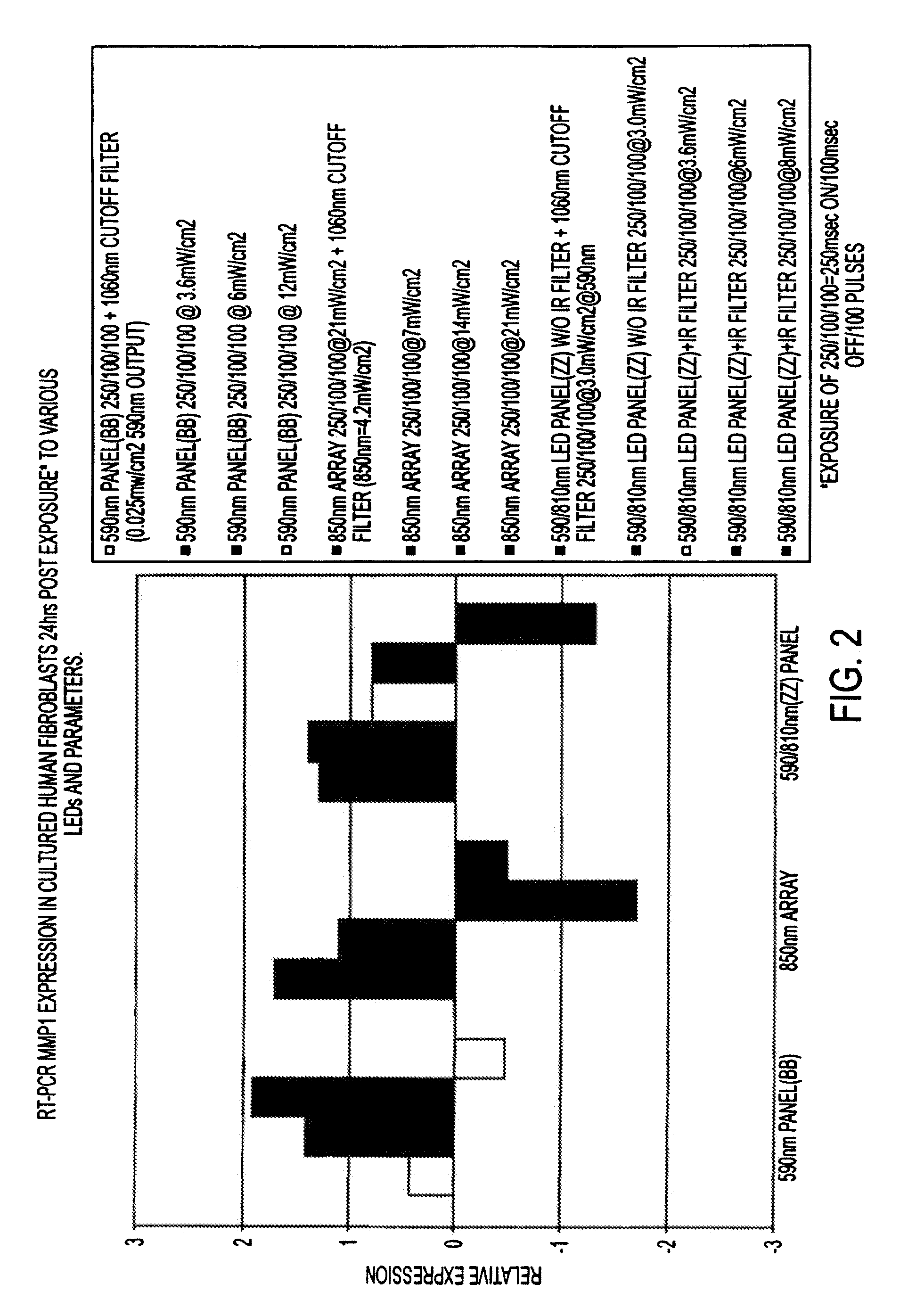System and method for the photodynamic treatment of burns, wounds, and related skin disorders
a photodynamic treatment and wound technology, applied in medical preparations, medical science, therapy, etc., can solve the problems of not only dying cells, but damaged cells, and inability to produce a system or method for reviving or rescuing necrotic cells or those in advanced stages of necrosis
Active Publication Date: 2010-06-03
LOREAL SA
View PDF99 Cites 8 Cited by
- Summary
- Abstract
- Description
- Claims
- Application Information
AI Technical Summary
Benefits of technology
[0024]One embodiment of the invention relates to reducing the undesirable effects and enhancing the beneficial effects of narrowband and wideband multichromatic electromagnetic radiation, as well as monochromatic radiation, emitted by sources including, but not limited to lasers (monochromatic and filtered, narrowband multichromatic), LED's (narrowband multichromatic), radio frequency, electromagnetic therapy or non ablative thermally mediated surgical procedures, etc. For example, LED photomodulation and other similar non-LED therapies may be used to enhance the desired effects or inhibit the undesirable one. This may be accomplished via means such as thermal injury to the skin which forces the expression of MMP and causing an increase structural proteins like collagen. LED light sources may also boost collagen while decreasing the upregulated MMP to produce a beneficial net effect. Such means generally quench the inflammatory processes that thermal therapies typically produce.
Problems solved by technology
These type of injuries produce not only damaged cells, but dying cells.
Damaged cells may either repair the damage and return to normal, repair the damage imperfectly and produce an abnormal or sub-optimally functioning cell, or the cells may die.
That is a wrinkle is really the result of accumulation of imperfectly repaired cell damage.
The pertinent arts have, heretofore, been unable to produce a system or method for reviving or rescuing necrotic cells or those in advanced stages of necrosis.
Typically these wound repair mechanisms are imperfect which is considered by many to be a solar scar.
The more destructive and traumatic methods use chemicals to peel off the stratum cornium epidermis and often a portion of the dermis or they mechanically abraded by sand papering or dermabrating or more recently high-energy thermal lasers have been used to vaporize or coagulate the skin.
These methods have a prolonged and painful wounding period and require wound care and patients typically must limit their daily social and business activities during the wound-healing phase.
These methods are notoriously known for producing many problems and sometimes even disfiguring scarring or catastrophic pigment changes in the skin.
However, properly performed and with good wound care, many people achieved significant and sometimes dramatic anti-aging effects.
Non-ablative methods have typically been thermal in nature and through various means of laser light, intense pulsed light, radio frequency or microwave energy delivery then produced a thermal injury to the dermis.
Results are occasionally traumatic but have been extremely variable with this therapy.
Method used
the structure of the environmentally friendly knitted fabric provided by the present invention; figure 2 Flow chart of the yarn wrapping machine for environmentally friendly knitted fabrics and storage devices; image 3 Is the parameter map of the yarn covering machine
View moreImage
Smart Image Click on the blue labels to locate them in the text.
Smart ImageViewing Examples
Examples
Experimental program
Comparison scheme
Effect test
examples
[0092]Attached hereto are graphs, tables of data, and examples that further illustrate the various embodiments of the invention, as well as lists of gene products which can be regulated by methods of the invention. In the appendix, the results of two experiments which illustrate the invention are shown.
the structure of the environmentally friendly knitted fabric provided by the present invention; figure 2 Flow chart of the yarn wrapping machine for environmentally friendly knitted fabrics and storage devices; image 3 Is the parameter map of the yarn covering machine
Login to View More PUM
 Login to View More
Login to View More Abstract
A method including photomodulating mammalian tissue with more than one light source of narrowband, multi chromatic electromagnetic radiation, wherein at least one light source emits radiation at a wavelength corresponding to yellow light and at least one light source emits radiation corresponding to infra-red light, wherein the ratio of the intensity of yellow light to infra-red light is about 4:1.
Description
CROSS REFERENCE TO RELATED APPLICATIONS[0001]This application is a continuation of U.S. application Ser. No. 10 / 903,483, filed Aug. 2, 2004, which is a non-provisional application of U.S. Provisional Application No. 60 / 491,277, filed Jul. 31, 2003, both of which are hereby incorporated by reference in their entirety.BACKGROUND OF THE INVENTION[0002]1. Field of the Invention[0003]This invention relates to method and devices for the photodynamic regulation of cell proliferation and gene expression. In particular, the invention relates to the reducing, reversing, and / or diminishing the effects of sunburn, thermal burns, chemical burns, radiation burns, various types of wounds, such as traumatic, surgical, laser, chemical peel, cosmetic surgery, warfare agents or injuries, freezing, hypoxia, vascular insufficiency, bruising, chronic ulcers, etc., allergic reactions or contact dermatitis, and various inflammatory diseases.[0004]2. Description of the Background[0005]Chronological aging, “...
Claims
the structure of the environmentally friendly knitted fabric provided by the present invention; figure 2 Flow chart of the yarn wrapping machine for environmentally friendly knitted fabrics and storage devices; image 3 Is the parameter map of the yarn covering machine
Login to View More Application Information
Patent Timeline
 Login to View More
Login to View More Patent Type & Authority Applications(United States)
IPC IPC(8): A61N5/06A61KA61N1/00
CPCA61N5/0616A61N2005/0662A61N2005/0659A61N2005/0652A61N5/06A61B18/00A61N2005/0663A61N2005/0667
Inventor MCDANIEL, DAVID H.
Owner LOREAL SA
Features
- R&D
- Intellectual Property
- Life Sciences
- Materials
- Tech Scout
Why Patsnap Eureka
- Unparalleled Data Quality
- Higher Quality Content
- 60% Fewer Hallucinations
Social media
Patsnap Eureka Blog
Learn More Browse by: Latest US Patents, China's latest patents, Technical Efficacy Thesaurus, Application Domain, Technology Topic, Popular Technical Reports.
© 2025 PatSnap. All rights reserved.Legal|Privacy policy|Modern Slavery Act Transparency Statement|Sitemap|About US| Contact US: help@patsnap.com



